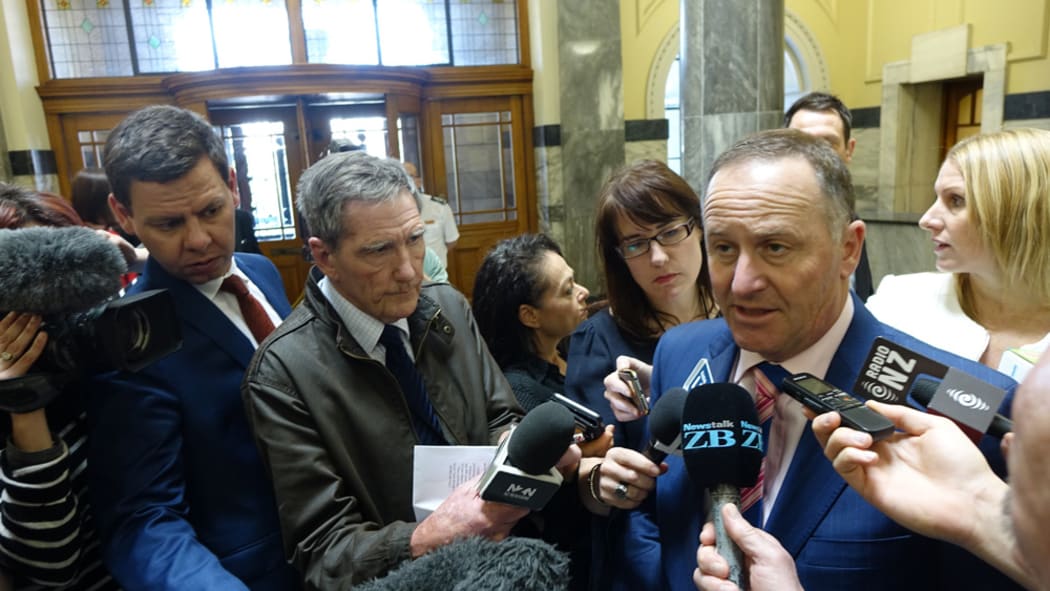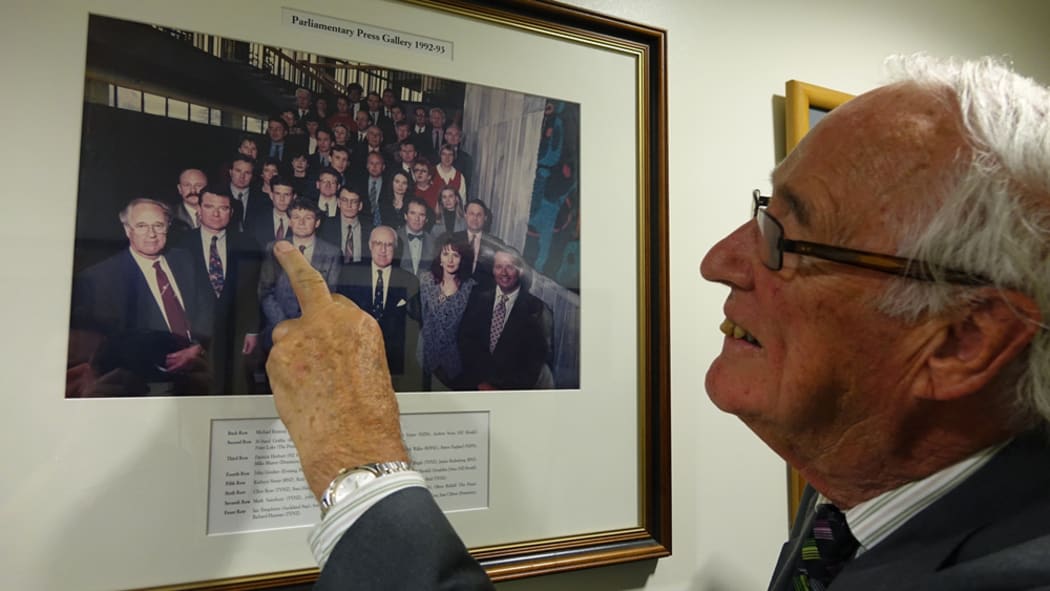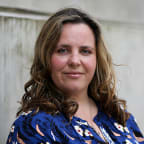Take a look behind the scenes at the Parliamentary Press Gallery, a place where truth can sometimes be stranger than fiction.

Press Gallery reporters in action at what's called 'the bridge' - doorstopping MPs and Ministers before they go into the House for Question Time. Photo: Chris Bramwell
The Parliamentary Press Gallery is a concrete block plonked next to the Beehive that houses about 45 journalists in peak hours. Former alumni include John Campbell, Heather du Plessis-Allan, Guyon Espiner and Duncan Garner.
The gallery's concrete block architecture can only be described as brutalist and it's been yellow-stickered as earthquake prone. It certainly can't be described as glamorous but it offers reporters handy access to Parliament and all its goings-on.
Political columunist for The Listener, Jane Clifton, says Parliament is a place where truth is stranger than fiction.
"People do say 'oh Parliament must be really boring', but it's actually not. I mean, some of the speeches can be boring but there's always something going on, quite often something quite mad and surreal."
She says coverage of the Prime Minister's penchant for ponytail pulling means comedians like John Oliver will never be short of material from New Zealand.
Or there's the sometimes bizarre pledges wannabe politicians make while electioneering.
"Somebody in the campaign trail swore on his left testicle that such and such was true so suddenly this obscure MP became famous because he talked about his left testicle," she says.
The gallery itself has a bit of a "school campus atmosphere", she says, and quotes former Press Gallery journalist/cartoonist Tom Scott: "He said it's a bit like a 24-hour pyjama party where everyone drops into everyone else's room, all times of the day and night."
If you break the rules in a serious way, deliberately, the Speaker can expel you from the Press Gallery.
The press gallery was established way back in 1870, when a reporter was first given a pass to cover a session of Parliament.
These days things are a little bit more regimented and journalists have to be accredited. Their membership can be suspended or cancelled if they break the rules.
The Herald's political deputy editor, Claire Trevett, is the chair of the gallery, and basically in charge of making sure journalists don't get into too much trouble.
The rules have got stricter in recent years, after journalists and camera-ops chased then Labour MP and Cabinet Minister Chris Carter down a stairwell at Parliament.
On another occassion, which didn't help either, TVNZ journalist at the time and now Labour MP, Kris Faafoi, chased an MP into the toilets.
Trevett says there are now about four places journalists are able to film or take photos but apart from that, they need permission from the Speaker.
"If you break the rules in a serious way, deliberately, the Speaker can expel you from the Press Gallery."
But she says in general press gallery reporters have a lot of freedom in terms of where they can go and how often they can talk to the Prime Minister and other politicians.
"We actually have more access around the precinct than MPs do because their swipe cards don't let them into rival parties' areas but we can go anywhere. But if we knock on the door and are told to 'bugger off' we have to bugger off."
She says the gallery is quite an addictive environment, which is why it has so many long-serving members.
"You have boring days but you hardly ever have boring weeks and people get addicted to it, to be honest," she says.
Radio New Zealand's political editor, Jane Patterson, says it may be a cut-throat industry but there's a collegiality to the gallery.
"With the younger journalists, when you come in here, it can be really daunting with all the different procedures and the rules and everything. It's all quite foreign. I found that some of the more senior journalists were incredibly generous with their advice and guidance."

Veteran press gallery reporter, Ian Templeton, points out a young John Campbell. Photo: Amelia Langford
She says political reporting is different to general news reporting as there is a symbiotic relationship between politician and reporter.
"If you're interviewing members of the public, you know, often you'll never see those people again..but here we're in a bit of a glass bowl and we report on the people that we have to work with everyday...
"Most politicians I've dealt with, if you're fair and you're accurate, they accept that they have to be held accountable."
And sticking around the gallery is seen as a badge of honour.
"In the press gallery, unlike maybe some jobs, you're not seen as a has-been if you've been here 10, 20 years. It's actually seen as quite a valuable thing."
In the press gallery, unlike maybe some jobs, you're not seen as a has-been.
The oldest member of the gallery, both in age and length of service, is Ian Templeton.
He's a member for life after being in the gallery for almost 60 years, which seems rather exotic to anyone from Generation X or Y and prone to job-hopping.
He won't disclose his age though, saying that's a "tightly-held secret" but says he started with the Auckland Star in 1957.
"I used to arrive at 8.30 and spend half an hour reading the papers and then I'd begin a tour of ministerial offices and call virtually at every office. Mostly on the secretaries because none of them had press secretaries in those days."
He says it was a more intimate atmosphere in those days and all the reporters were stationed in one room.
He says his age is also an advantage when talking to politicians: "Possibly because I have been here so long they seem to regard me as they would a grandfather and I find them quite easy to get on with them."
This content was made for The Wireless with funding from Parliament.


